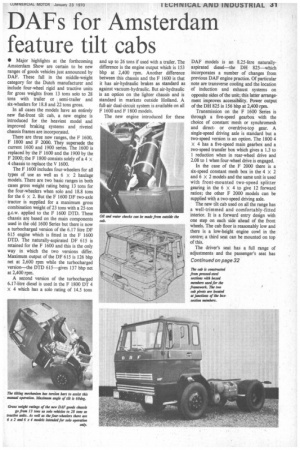DAFs for Amsterdam feature tilt cabs
Page 33

Page 34

If you've noticed an error in this article please click here to report it so we can fix it.
• Major highlights at the forthcoming Amsterdam Show are certain to be new ranges of goods vehicles just announced by DAF. These fall in the middle-weight category for the Dutch manufacturer and include four-wheel rigid and tractive units for gross weights from 13 tons solo to 28 tons with trailer or semi-trailer and six-wheelers for 18.8 and 22 tons gross.
In all cases the models have an entirely new fiat-front tilt cab, a new engine is introduced for the heaviest model and improved braking systems and riveted chassis frames are incorporated.
There are three new ranges, the F 1600, F 1800 and F 2000. They supersede the current 1600 and 1900 series. The 1600 is replaced by the F 1600 and the 1900 by the F 2000; the F 1800 consists solely of a 4 X 4 chassis to replace the V 1600.
The F 1600 includes four-wheelers for all types of use as well as 6 X 2 haulage models. There are two basic ranges in both cases gross weight rating being 13 tons for the four-wheelers when solo and 18.8 tons for the 6 X 2. But the F 1600 DF two-axle tractor is supplied for a maximum gross combination weight of 23 tons with a 25-ton g.c.w. applied to the F 1600 DTD. These chassis are based on the main components used in the old 1600 Series but there is now a turbocharged version of the 6.17 litre DF 615 engine which is fitted in the F 1600 DTD. The naturally-aspirated DF 615 is retained for the F 1600 and this is the only way in which the two versions differ. Maximum output of the DF 615 is 126 bhp net at 2,600 rpm while the turbocharged version—the DTD 615—gives 137 bhp net at 2,400 rpm.
A second version of the turbocharged 6.17-litre diesel is used in the F 1800 DT 4 X 4 which has a solo rating of 14.5 tons
and up to 26 tons if used with a trailer. The difference is the engine output which is 153 bhp at 2,400 rpm. Another difference between this chassis and the F 1600 is that it has air-hydraulic brakes as standard as against vacuum-hydraulic. But air-hydraulic is an option on the lighter chassis and is standard in markets outside Holland. A full-air dual-circuit system is available on all F 1600 and F 1800 models.
The new engine introduced for these
DAF models is an 8.25-litre naturallyaspirated diesel—the DH 825—which incorporates a number of changes from previous DAF engine practice. Of particular note are transverse cooling and the location of induction and exhaust systems on opposite sides of the unit; this latter arrangement improves accessibility. Power output of the DH 825 is 156 bhp at 2,400 rpm.
Transmission on the F 1600 Series is through a five-speed gearbox with the choice of constant mesh or synchromesh and director overdrive-top gear. A single-speed driving axle is standard but a two-speed version is an option. The 1800 4 X 4 has a five-speed main gearbox and a two-speed transfer box which gives a 1.3 to 1 reduction when in rear-wheel drive and 2.08 to 1 when four-wheel drive is engaged.
In the case of the F 2000 there is a six-speed constant mesh box in the 4 X 2 and 6 X 2 models and the same unit is used with front-mounted two-speed splitter gearing in the 6 X 4 to give 12 forward ratios; the other F 2000 models can be supplied with a two-speed driving axle.
The new tilt cab used on all the range has a welt-trimmed and comfortably-fitted interior. It is a forward entry design with one step on each side ahead of the front wheels. The cab floor is reasonably low and there is a low-height engine cowl in the centre; a third seat can be mounted on top of this.
The driver's seat has a full range of adjustments and the passenger's seat has folding armrests. Two-speed electric wipers and electrically-operated washers are standard and a large capacity heater is fitted. A number of adjustable outlets are provided and demister slits are located over the full length of the dash below the screen and under the corner windows on each side.
Particular attention has been paid to insulation of the cab against heat and noise. The floor is covered with a thick rubber mat on a foam-plastics base and the cab front has insulating material with a top layer of rubber. The doors, walls and roof of the cab are trimmed in vinyl.
Two torsion bars are incorporated in the tilting mechanism of the cab and do much of the work when the cab is tilted forward. A holding device secures the cab at its maximum tilt of 60deg in which position the engine is fully exposed. And because the power unit is well set back from the front end of the chassis the front of the engine, the water pump, belt-driven components and the radiator can also be reached easily. The cab does not have to be tilted to check oil and water levels; these checks can be made from outside the vehicle as the filling points and engine dipstick are positioned just behind the cab on the left-hand side.








































































































